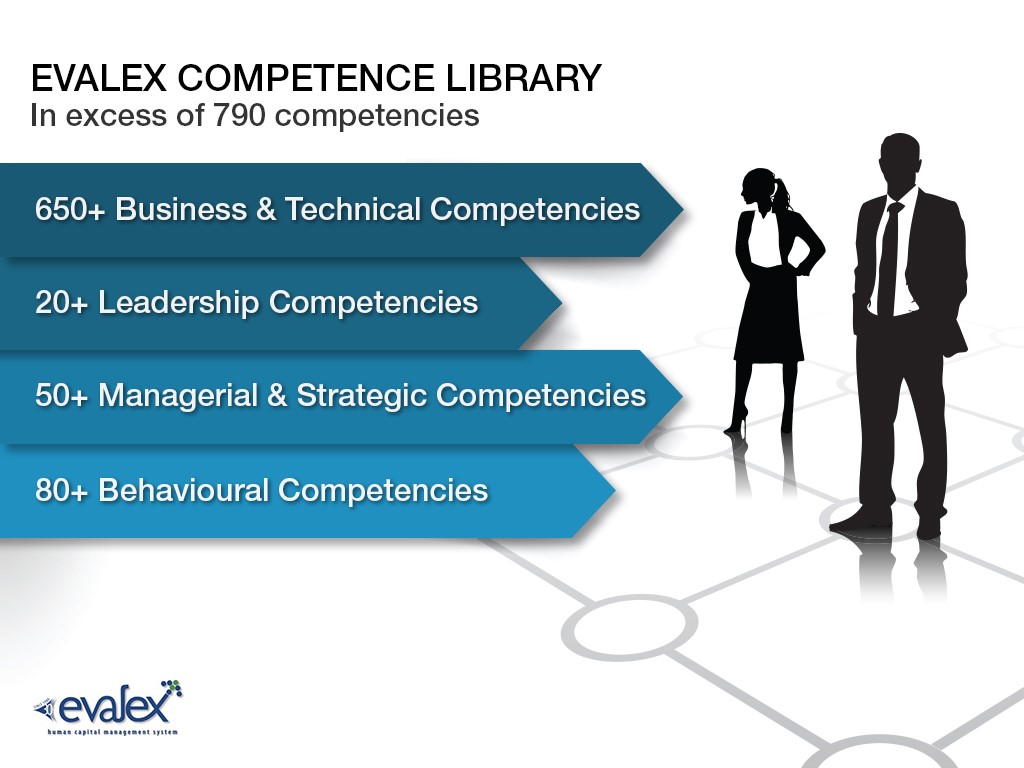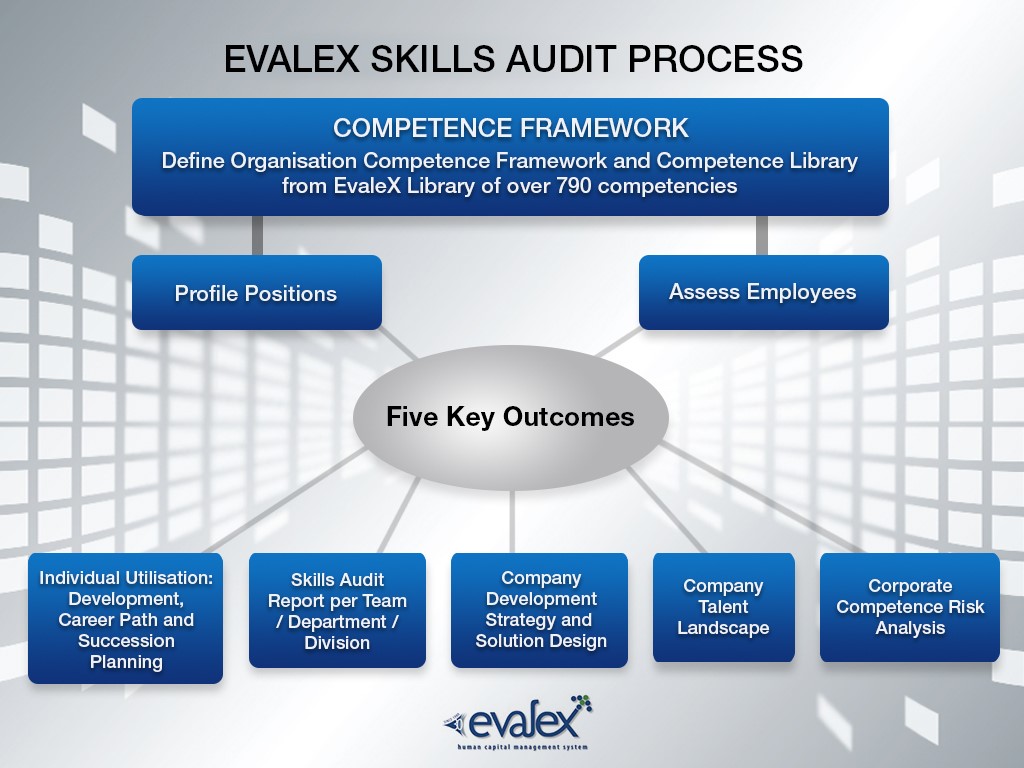Competence Library
The Evalex Talent Management System has at its core one of the most comprehensive competence libraries available in the market. With 23 competency domains, 115 sub-domains, 750 competencies and 6 100 competency facets at your disposal, the task of accurate job profiling just got a whole lot easier.
Job profiling is one of the cornerstones of any human resource or human capital process. The Evalex philosophy dictates that profiling needs to happen at three levels:
- Profiling the position in terms of position level (Evalex has a built-in levels of work “calculator” to achieve this)
- Profiling the position in terms of the outputs, objectives or goals to be achieved (Evalex has a comprehensive, fully-fledged performance management module to achieve this)
- Profiling the position in terms of the competencies required to achieve the objectives or purpose of the role
 Unlike other systems, Evalex profiles competencies across the following domains:
Unlike other systems, Evalex profiles competencies across the following domains:
- Cognitive
- Behavioural
- Leadership/managerial
- Strategic
- Business
- Technical
These competencies can be assessed using just three assessment tools, namely:
- Assessment Centre (for leadership and managerial competencies)
- Psychometrics (for behavioural and cognitive competencies)
- The Evalex Competence Inventory (for business and technical competencies)
Unpacking competencies
Unlike most competency systems, Evalex differentiates between proficiency levels and competency levels. It is therefore two-dimensional, whereas most other systems are one-dimensional. At Evalex we first determine the proficiency level at which the person can function at (levels of work) then the competency level. Given four proficiency levels and eight competency levels, a 32-point scale is achieved that allows for very fine differentiation among staff.
Competencies themselves are divided into three classes, namely transactional, operational and strategic. Evalex has the capability to define and profile a position in terms of both technical and behavioural competencies. This allows for full integration of psychometric assessments with technical competence assessments, covering all drivers of performance.
Each competency in the Evalex library has a name, descriptor and set of proficiency levels aligned with the Elliot Jacques Levels of Work theory. The only exception here is the behavioural component, which is assessed through psychometrics. The behaviours expected for the competency at each level of work have, however, been described in detail with an even progression of complexity.
Evalex Competence
Evalex Competence is one of the most elegant and effective systems for profiling roles and assessing individuals against them. In the design and development of the Evalex Competence system we focused on what companies need to achieve when profiling positions and people. Evalex Competence also enables your organisation to do comprehensive skills audits.
Evalex Competence offers the following:
 A competence library consisting of 23 domains, including finance, sales, operations and manufacturing. More than 700 technical, behavioural, leadership and strategic competencies are described in detail across all domains, with the requirement at six levels of work for each
A competence library consisting of 23 domains, including finance, sales, operations and manufacturing. More than 700 technical, behavioural, leadership and strategic competencies are described in detail across all domains, with the requirement at six levels of work for each
- Both level of complexity and level of competence are assessed
- Individuals are either assessed against a job profile or on competence acquired through work experience. Assessment against the job profile indicates job fit, whereas assessment of competencies generates an individual competence map, providing a more holistic view of the person’s human capital value to your organisation. This is particularly relevant for organisations that link remuneration to competence rather than job level
- A high level corporate skills risk profile, which indicates the key competencies for corporate survival and the extent of risk/strength of each, allowing you to prioritise these for talent acquisition and development
- Individual Competence Map (ICM): Why read through an applicant’s CV to try and work out what competencies they have acquired over their entire work life experience? Then how do you compare multiple applicants to determine best position fit? In doing an Evalex Competence Inventory (ECI) you will be provided with an ICM for each applicant, with data analytics for easy comparisons. The ICM is a heat-map indicating where in your organisation an individual will fit best
- Career path planning: The ICM provides clear direction as to which career path within a job family or in the broader organisation the individual can follow
- Succession planning: The system can provide a succession shortlist for each position indicating percentage fit for each candidate as well as what development should take place building up to the impending promotion.
Evalex Competence Inventory
The Evalex Competence Inventory (ECI) and Evalex Competence Map (ECM) are the two options available when using the Evalex Competence system for recruitment and selection or skills audits.
For skills audits against specific roles the process starts by formulating a company competence library. This involves creating your company in our system and importing from the main library those competencies that drive success in your culture. The next step is to create the positions in the system and profile them in terms of the competence requirements. The system then auto-generates the competence questionnaire based on the profiled position and the candidate completes the assessment. Once assessed, multiple report formats are available. A job-fit report indicating position fit, an interviewer report to facilitate recruitment interviews, a development report and many more.
ECM is a revolutionary way of determining whether a candidate or applicant has the required competencies for the job and makes comparisons across candidates very easy.
Why do you have to invest time reading through multiple CVs to extract the competence range and level of an applicants if the ECM can generate CVs that are instantly comparable to each other and the job? ECM guides the applicant to describe his/her competencies according to the competence requirements of the job, rather than chronologically.
Let us take the example of a financial position. For each candidate the ECM provides a visually appealing diagram or map of all the competencies in a financial department and, in heat-map format, highlight the extent of experience and level of experience of the candidate in each. Visualise a road map of a city, where the main arterial roads are highlighted in bold in different colours and you get the idea of the ECM. The system makes it really easy to look at the competencies in a sub-section of finance to see if the candidate fits, where else in finance s/he has got experience and to compare different candidates with each other. The roadmap looks the same, but the highlighted paths and routes are different for each individual.


